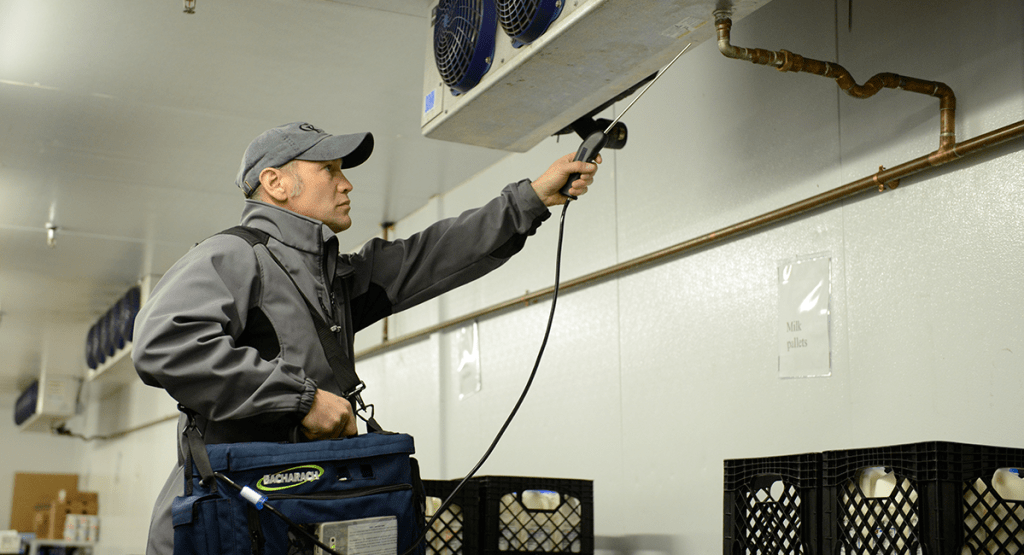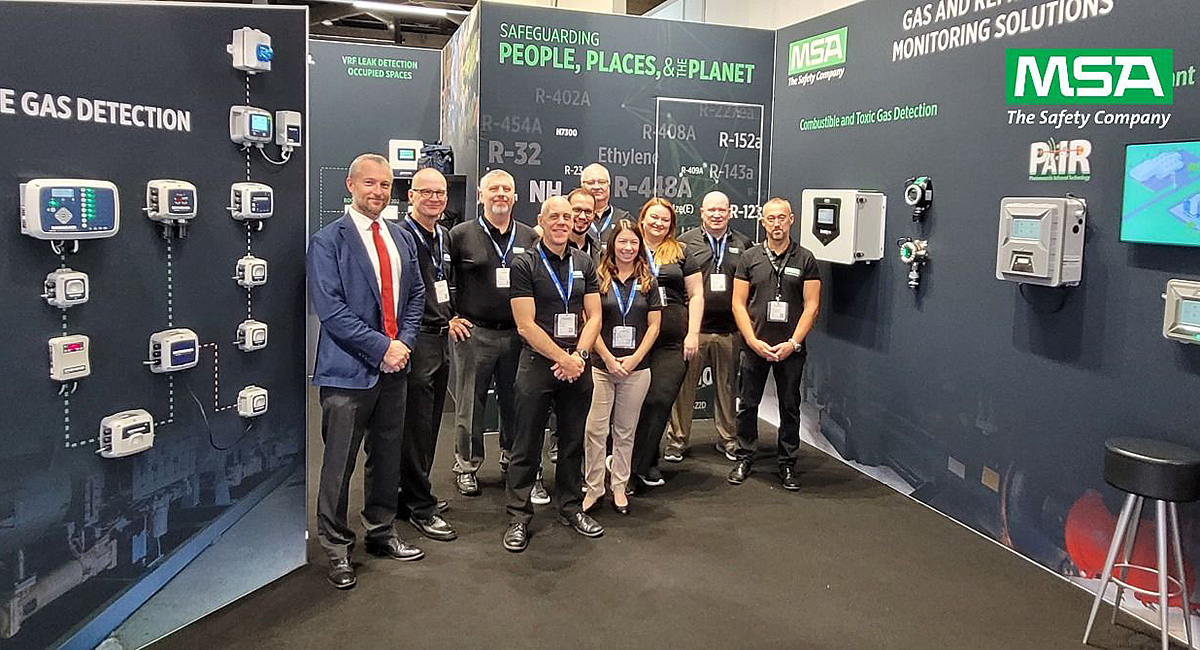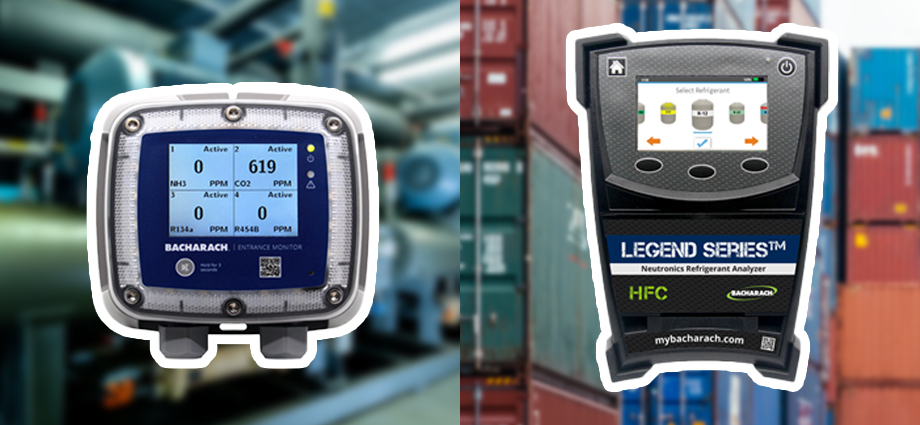
The California Refrigerant Management Program (RMP) regulates facilities that use high global warming potential (GWP) refrigerant in certain stationary, non-residential refrigeration equipment.
Owners, operators and/or those who service such equipment are subject to refrigerant compliance requirements, including for leak inspections, service recordkeeping and reporting. Let’s take a closer look at these requirements for RMP-regulated facilities.
Identifying RMP-Regulated Facilities
Regulation typically impacts facilities with large commercial refrigeration systems, such as cold-storage warehouses, distribution facilities, ice rinks, supermarkets/grocery stores, and manufacturing plants.
What Facilities and Systems Are Affected?
Whether your facility is subject to the California Refrigerant Management Program (RMP) requirements depends on whether refrigerant onsite is considered “high-GWP,” and what the full refrigerant charge of a system is.
Per the CARB RMP regulation, high-GWP refrigerant includes refrigerant with a GWP value equal to or greater than 150, and any facility with a stationary refrigeration with a full charge of over 50 pounds of such high-GWP refrigerant is regulated.
Now, the specific compliance requirements depend on the Facility Category and System Category.
Facility Category
Facilities are classified into three sizes: large, medium, and small. Such sizes are based on the full refrigerant charge of the largest system that is operating at your facility (weight of high-GWP refrigerant contained).
- Large facility — Facility with a refrigeration system with a full charge greater than or equal to 2,000 pounds of a high-GWP refrigerant.
- Medium facility — Facility with a refrigeration system with a full charge greater than or equal to 200 pounds but less than 2,000 pounds of a high-GWP refrigerant.
- Small facility — Facility with a refrigeration system with a full charge greater than 50 pounds but less than 200 pounds of a high-GWP refrigerant.

Program requirements, particularly as it pertains to reporting, depend on your facility category, and we will discuss this in more detail later on in the article.
System Category
Additionally, there are three categories for refrigeration systems containing more than 50 pounds of high-GWP refrigerant, and they are as follows:
- Large system — Refrigeration system with a full charge greater than or equal to 2,000 pounds.
- Medium system — Refrigeration system with a full charge greater than or equal to 200 pounds but less than 2,000 pounds.
- Small system — Refrigeration system with a full charge greater than 50 pounds but less than 200 pounds.

The classification of your system impacts the leak detection and monitoring requirements you must adhere to.
Overview of Leak Detection & Monitoring Requirements
The California refrigerant management program has stringent leak detection and monitoring requirements for regulated facilities, and you will need to ensure that your various systems are properly being inspected and/or monitored.
How Often Must A System Be Inspected for Leaks?
Leak inspection intervals are based on the system category (i.e., large, medium or small).
Large System Requirements
Certain large systems are subject to automatic leak detection (ALD) monitoring requirements.
Mandated Automatic Leak Detection Monitoring
That is, the owner or operator of a large refrigeration system, that operates year round, or is intended to operate year-round, must install an automatic leak detection system if
- The refrigerant circuit is located entirely within an enclosed building or structure, or
- The compressor, evaporator, condenser, or any other component of the refrigeration system(s) with a high potential for a refrigerant leak is located inside an enclosed building or structure.
The automatic leak detection system must meet certain specifications and be audited and calibrated annually.
More specifically, section 95385 specifies the ALD requirements, which include direct leak detection and indirect leak detection.
Direct Leak Detection (Detects Refrigerant in Air)
A direct leak detection system detects the presence in air of a high-GWP refrigerant. You must annually audit and calibrate such a system using manufacturer recommended procedures, so that it accurately detects a concentration level of 10 parts per million of vapor of the specific refrigerant(s) used in the system(s), and alerts the operator when a refrigerant concentration of 100 parts per million of vapor of the specific refrigerant(s) used in the system(s) is reached.
- Detects 10 ppm of vapor of the specific refrigerant(s) used in your system(s)
- Alarms when 100 ppm concentration and greater
- Audit and calibrate annually
Indirect Leak Detection (Interprets System Measurements)
An indirect detection system automatically interprets measurements to indicate a refrigerant leak. You must annually audit and calibrate the system, so that it will automatically alert the operator when measurements indicate a loss of refrigerant of 50 pounds or 10 percent of the refrigeration system full charge, whichever is less.
If an ALD (direct or indirect) alerts you pursuant to the above specifications (per section 95385(a)(5) or 95385(a)(6) of the regulation), you must ensure that a leak inspection is conducted within 24 hours after the system alert.
Bacharach Leak Detection Systems Meet ALD Requirements
Bacharach offers two leak detection systems that meet CARB ALD requirements—namely, the Multi-Zone and the MGS-250. Both leak detection systems are based on infrared sensor technology and can accurately detect concentrations levels of 10 ppm and alarm at 100 ppm as required.
The main difference between the two systems is the method applied to how the refrigerant is delivered to the sensor.
Multi-Zone
The Multi-Zone is a sampling system that sequences between connected sampling points, and refrigerant is delivered to a centrally located sensor.
MGS-250
The MGS-250 is a distributed point detection system, in which the sensor is mounted at the possible point of a leak and the refrigerant diffuses into the sensor.
The point is, both Bacharach leak detection systems fulfill the requirements of the California Refrigerant Management Program. The main differences are the size of the infrared sensor and the gas delivery system. The right leak detection system for you depends on your application specific requirements; contact one of our experts to assist you in finding the right solution to comply with these CARB ALD requirements.
Now that we’ve addressed which large refrigeration systems are subject to ALD requirements, it’s important to note that those large refrigeration systems that do not operate with the refrigerant circuit located entirely within an enclosed building or structure must conduct a leak inspection once every three months.
Thus, leak inspection and monitoring requirements for large systems depend upon whether the system is fully enclosed or non-enclosed. After discussing requirements for large refrigeration systems in full, let’s move onto the other two system categories: medium and small.
Medium System Requirements
The owner or operator of a medium refrigeration system must conduct a leak inspection of the refrigeration system once every three months. However, a leak inspection is not required if a CARB compliant ALD is installed.
Small System Requirements
The owner or operator of a small refrigeration system must annually conduct a leak inspection of the refrigeration system. Again, such leak inspection is not required if a CARB compliant ALD is installed.
Proper Leak Inspection Methods
Keep in mind that, per the CARB RMP regulation, leak inspections must be conducted using a calibrated refrigerant leak detection device, a bubble test, or observation of oil residue. We recommend an electronic refrigerant leak detection method, as it is the most precise and efficient.
If A Leak Is Detected, When and How Should It Be Repaired?
All detected leaks must be repaired. As such, ensure that you adhering to the CARB RMP leak repair requirements, which include the 14-day repair requirement and initial and follow-up verification tests.
14-Day Repair Requirement
Specifically, a refrigerant leak must be repaired by a certified technician within 14 days of its detection, except in situations when a longer time period is allowed under subsections (c),(d), or (i) of § 95386.
Initial and Follow-Up Verification Tests
Both an initial and follow-up verification test must be conducted upon the completion of refrigerant leak repairs.
A summary of the CARB leak inspection and repair requirements can be found in the image below:
Importantly, our Parasense Platform, a refrigerant management software, has this regulation workflow built into its process map, which means the software knows what is needed in any given situation and coordinates accordingly.
Overview of Registration, Reporting & Recordkeeping Requirements
Lastly, there are recordkeeping, registration and reporting requirements a part of the California Refrigerant Management Program.
Registration Requirements
Large, medium, and small facilities must register with CARB by March 1 of the calendar year after the calendar year in which the refrigeration system begins operating at the facility.
Registration information requirements include facility information and refrigeration system information.
Reporting Requirements
Large and medium facilities must submit annual reports for the previous calendar year by March 1 of each year. The annual report must include refrigeration system information; refrigeration system service and leak repair information; and refrigerant purchases and use information.
While small facilities are not required to submit annual reports, they must report the information specified in § 95388 within 60 days of receipt of a request by the Executive Officer.
Recordkeeping Requirements
All RMP-regulated facilities must maintain records pursuant to § 95389 for a minimum of 5 years.
In fact, the records must be kept at the facility where the refrigeration system(s) is in operation and must be made available to an authorized representative of the Executive Officer, including a local Air Pollution Control Officer, upon request.
Bacharach Offers A Suite of Solutions for CARB Refrigerant Compliance
Ultimately, Bacharach offers a suite of solutions to achieve CARB refrigerant compliance. As mentioned, not only do we offer leak detection systems to meet ALD requirements but we also feature our Parasense Platform to capture all the information you need for compliance.
At Bacharach, we make it easy for you to achieve CARB refrigerant compliance, and we hope you found this article helpful.






